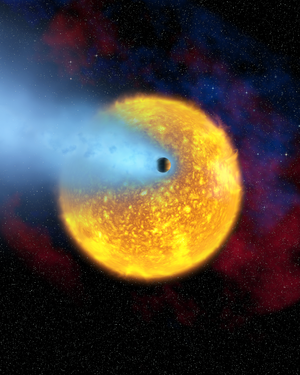
Chthonian planet
Encyclopedia

Gas giant
A gas giant is a large planet that is not primarily composed of rock or other solid matter. There are four gas giants in the Solar System: Jupiter, Saturn, Uranus, and Neptune...
's hydrogen
Hydrogen
Hydrogen is the chemical element with atomic number 1. It is represented by the symbol H. With an average atomic weight of , hydrogen is the lightest and most abundant chemical element, constituting roughly 75% of the Universe's chemical elemental mass. Stars in the main sequence are mainly...
and helium
Helium
Helium is the chemical element with atomic number 2 and an atomic weight of 4.002602, which is represented by the symbol He. It is a colorless, odorless, tasteless, non-toxic, inert, monatomic gas that heads the noble gas group in the periodic table...
atmosphere and outer layers, which is called hydrodynamic escape
Hydrodynamic escape
Hydrodynamic escape refers to a thermal atmospheric escape mechanism that can lead to the escape of heavier atoms of a planetary atmosphere through numerous collisions with lighter atoms....
. Such atmospheric stripping is a likely result of proximity to a star
Star
A star is a massive, luminous sphere of plasma held together by gravity. At the end of its lifetime, a star can also contain a proportion of degenerate matter. The nearest star to Earth is the Sun, which is the source of most of the energy on Earth...
. The remaining rocky
Rock (geology)
In geology, rock or stone is a naturally occurring solid aggregate of minerals and/or mineraloids.The Earth's outer solid layer, the lithosphere, is made of rock. In general rocks are of three types, namely, igneous, sedimentary, and metamorphic...
or metal
Metal
A metal , is an element, compound, or alloy that is a good conductor of both electricity and heat. Metals are usually malleable and shiny, that is they reflect most of incident light...
lic core
Planetary core
The planetary core consists of the innermost layer of a planet.The core may be composed of solid and liquid layers, while the cores of Mars and Venus are thought to be completely solid as they lack an internally generated magnetic field. In our solar system, core size can range from about 20% to...
would resemble a terrestrial planet
Terrestrial planet
A terrestrial planet, telluric planet or rocky planet is a planet that is composed primarily of silicate rocks or metals. Within the Solar System, the terrestrial planets are the inner planets closest to the Sun...
in many respects.
HD 209458 b
HD 209458 b
HD 209458 b is an extrasolar planet that orbits the Solar analog star HD 209458 in the constellation Pegasus, some 150 light-years from Earth's solar system, with evidence of water vapor....
is an example of a planet
Planet
A planet is a celestial body orbiting a star or stellar remnant that is massive enough to be rounded by its own gravity, is not massive enough to cause thermonuclear fusion, and has cleared its neighbouring region of planetesimals.The term planet is ancient, with ties to history, science,...
that is in the process of having its atmosphere stripped away, though it is not itself a chthonian planet nor is it expected to become one in the near future.
COROT-7 b may be the first chthonian planet discovered. Kepler-10b
Kepler-10b
Kepler-10b is the first confirmed terrestrial planet to have been discovered outside the Solar System. Discovered after several months of data collection during the course of the NASA-directed Kepler Mission, which aims to discover Earth-like planets crossing in front of their host stars, the...
is also the second chthonian planet found.
Chthonia (from ) means "of the Earth". The term was coined by Hébrard et al., since the term chthonian generally refers to Greek deities from the infernal underground.
See also
- Hot JupiterHot JupiterHot Jupiters are a class of extrasolar planet whose mass is close to or exceeds that of Jupiter...
- COROT-7b: diameter 1.7 x Earth, mass 4.8 x Earth, orbital periodOrbital periodThe orbital period is the time taken for a given object to make one complete orbit about another object.When mentioned without further qualification in astronomy this refers to the sidereal period of an astronomical object, which is calculated with respect to the stars.There are several kinds of...
= 20.5 hours (super-EarthSuper-EarthA super-Earth is an extrasolar planet with a mass higher than Earth's, but substantially below the mass of the Solar System's gas giants. The term super-Earth refers only to the mass of the planet, and does not imply anything about the surface conditions or habitability...
candidate) - Hypothetical planetHypothetical planetA hypothetical Solar System object is a planet, natural satellite or similar body in our Solar System whose existence is not known, but has been inferred from observational scientific evidence. Over the years a number of hypothetical planets have been proposed, and many have been disproved...

